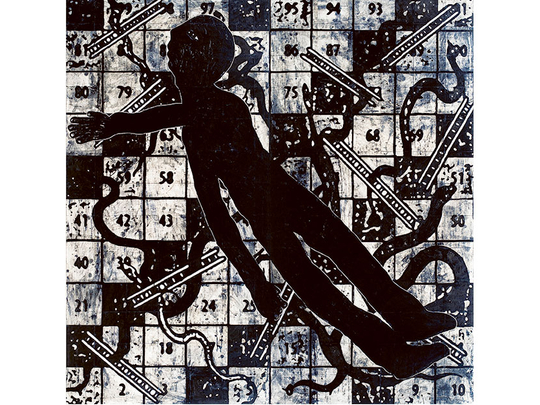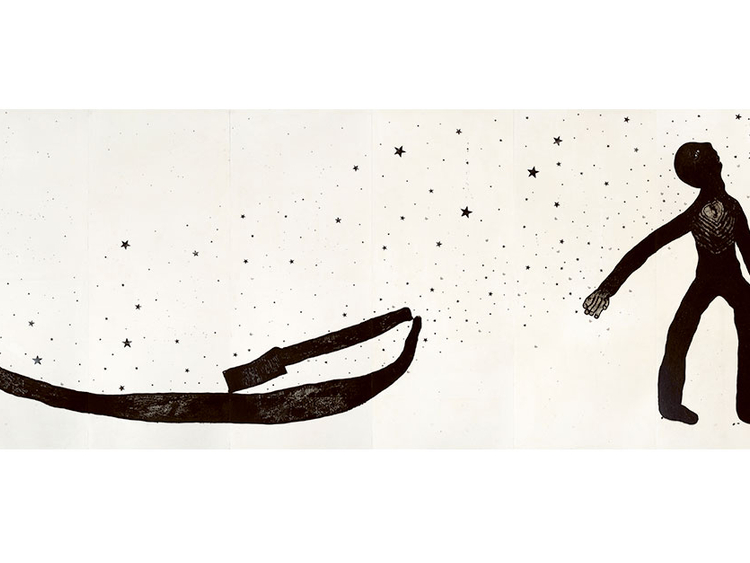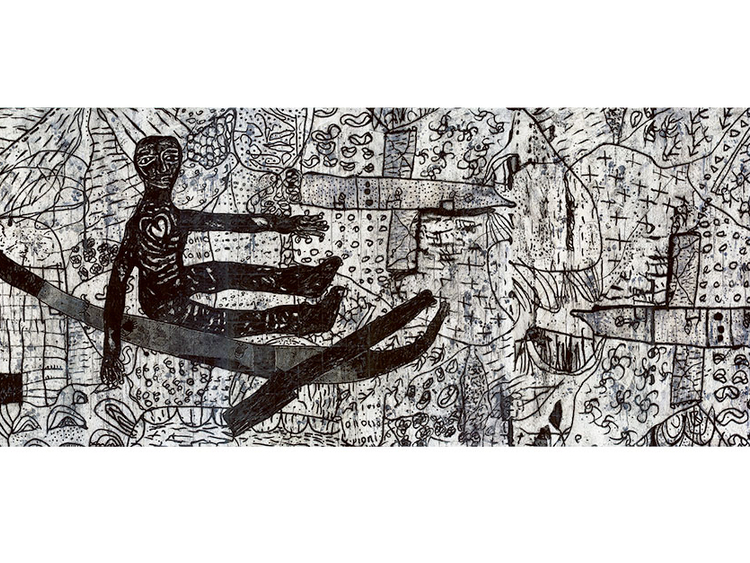
Iraqi artist Sadik Kwaish Alfraji has been living in exile in the Netherlands for many years. The dark, melancholy figures in his paintings speak about loss, exile, fragmentation, displacement and the struggles of human existence. His latest exhibition in Dubai, “Driven by Storms (Ali’s Boat)” also addresses these themes, but with a tinge of playfulness. The artworks have a childlike quality, because they are inspired by a drawing made by his nephew, Ali, when he was 10 years old.
The show, curated by Nat Muller, features large scale paintings, charcoal drawings, sketches from the artist’s diary and stop-motion video animation works. The artworks are filled with references to childhood such as Ali’s childish drawing of a boat; butterflies created with a stamp Alfraji found in his children’s toy box; a landscape of Baghdad copied from a child’s drawing; and the recurring motif of snakes and ladders from the children’s board game to symbolise the ups and downs in life.
The artworks convey the turmoil in the heart of a young boy who wishes to escape the horrors of present day Iraq, and of the artist who longs to go back to the Baghdad of his childhood. But they are not just about Ali’s or Alfraji’s story. They speak about every human being’s internal and external struggle, and the dreams that keep them going in the journey of life.
We spoke to Alfraji, about his work and the storms that propel his boat. Excerpts:
What is the inspiration behind this show?
In 2009, I went to Baghdad after 20 years of exile. The day I was leaving, my little nephew Ali handed me a sealed envelope, requesting me to open it only after leaving Iraq. It was a letter in which he had written his own and his brother’s names and the names of my children. Below that he had drawn a boat, with the words ‘I wish this boat takes me to you’.
That simple yet complex message touched me deeply. I could see that the little boy had put all his dreams in this boat. It was his magic boat that could take him far away from the hell of Iraq. I understood his feelings because this was the same boat that I always dreamt about when I lived in Iraq and wanted to flee from all the terrible things happening around me.
But it is also the same boat that I still dream about to take me back to the Baghdad of my childhood. I know this is an impossible dream because the Baghdad of today in not the city I once knew and had a strong bond with. So, this entire body of work is about this letter and this boat, which is Ali’s boat, my boat and everybody’s boat.
Each of us has our own shiny, beautiful boat that we hope will help us to flee from the problems that exist around us and within us. We know that it is impossible to escape these ‘problems of our existence’, but we still keep trying. Our life is like a storm that drives us, and we cannot stop.
What is the story behind the other drawing displayed alongside Ali’s letter in your exhibition?
This is a drawing gifted to me by a small child in the 1980s, and I have kept it all these years because I love it. It is a pencil drawing of a bird’s-eye-view of Baghdad. I have shown Ali’s boat flying over this exact cityscape in a painting and animation work titled, “Flying over Baghdad”. To me, these drawings capture the purity of a child’s feelings about the things we are missing.
In the painting “Take your boat and abandon your home”, why have you shown the figure walking away from the boat?
He is walking away from the boat, but the boat is following him. We always talk about following our dreams, but I believe that our dreams follow us. The fact of our existence is that we can never be released from our dreams, and this is what keeps us going forward. The title of this painting is inspired by the story of Noah, and I made the figure a bit like a superhero, for whom nothing is impossible.
What do you want to convey in “Don’t put all your dreams in one boat”?
Each of the heads piled up in the boat represents a dream. Besides the obvious message of losing everything if you lose that one boat, I also wanted to say that we always feel like we are missing something in life because we have so many dreams. If we had one wish, we would be clear about the direction we want to sail in, but we have so many that we get confused and lose our way. I can also see a subconscious reference to media images of desperate people trying to flee from war and violence in boats.
Why did you choose the unusual format of the installation on the floor?
I decided to enclose these sketches in acrylic boxes and arrange them on the floor because I wanted viewers to get the feeling of standing at the edge of the sea, about to embark on a scary yet exciting journey into the vast unknown. This installation is like a still animation, with each figure looking at the horizon and dreaming of something.
Why did you use only black in this body of work?
I have used Indian ink, charcoal, graphite pencil and black and white prints, because I feel black is intensely expressive and it freezes a moment, making it timeless. I feel I am growing with black, and this colour is always with me as an artist and as a human being.
Jyoti Kalsi is an arts enthusiast based in Dubai.
The show will run at Ayyam Gallery, Al Quoz until April 30.













